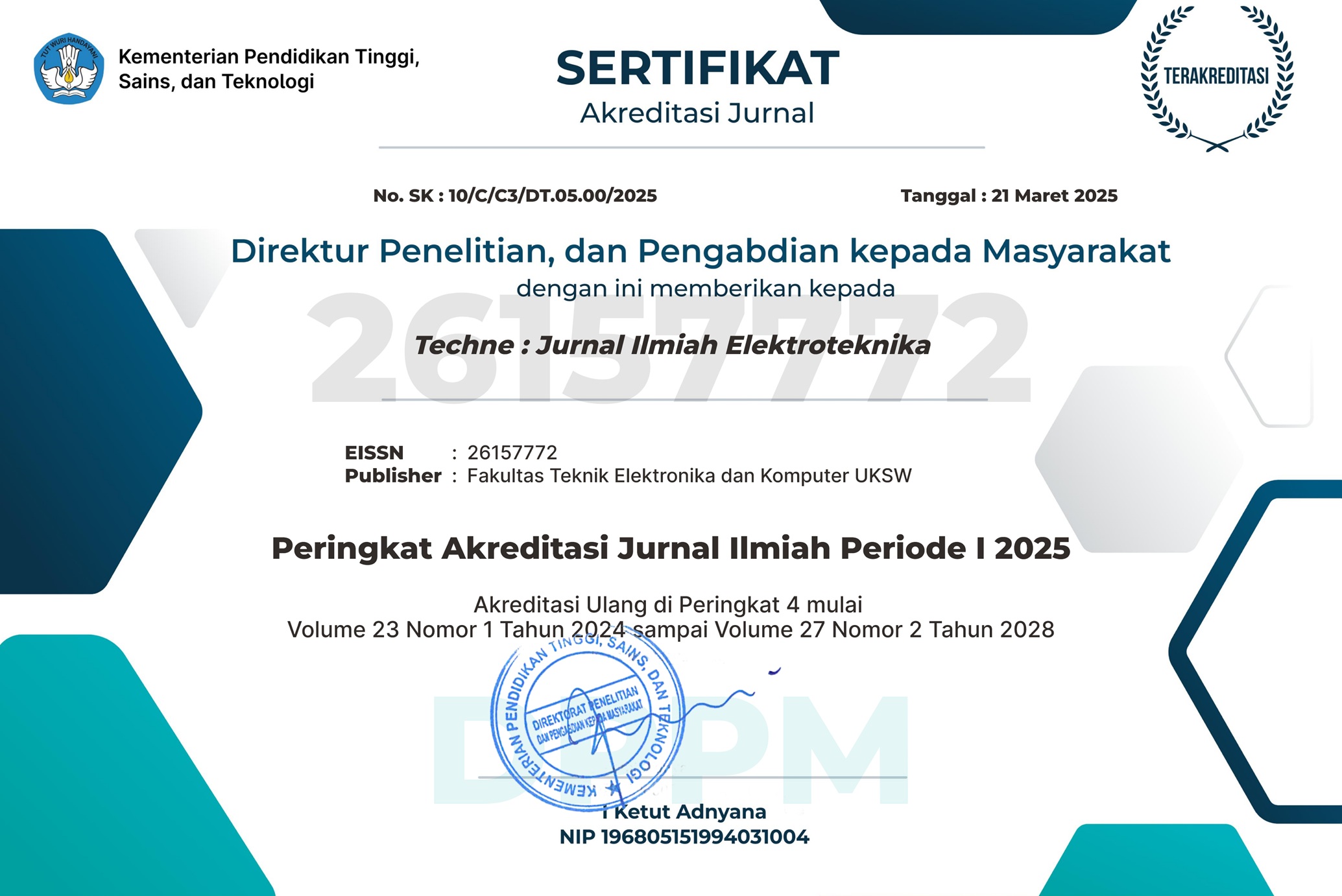Kontrol Relay dan Kecepatan Kipas Angin Direct Current (DC) dengan Sensor Suhu LM35 Berbasis Internet of Things (IoT)
DOI:
https://doi.org/10.31358/techne.v19i01.224Keywords:
Internet of Things (IoT), Arduino IDE, BlynkAbstract
Dewasa ini masyarakat banyak tertarik dengan hal-hal yang instan dan efisien. Selain itu angka mobilitas yang tinggi menjadi salah satu faktor mengapa hal-hal yang bersifat instan dan efisien menjadi pilihan yang banyak digemari oleh masyarakat. Menjawab tantangan ini Internet of Things (IoT) hadir untuk membantu masyarakat dengan cara mengkoneksikan berbagai objek ke jaringan internet yang kemudian dapat diakses dari mana saja. Penelitian ini bertujuan untuk mengetahui kinerja sistem IoT dengan platform aplikasi Blynk pada smartphone android. Metode yang digunakan adalah penggunaan sensor suhu LM35 sebagai input suhu. Pada perancangan ini menggunakan motor Direct Current (DC) yang dapat diatur dengan metode Pulse Width Modulation (PWM) dan dikendalikan melalui aplikasi Blynk pada smartphone android. Sensor suhu LM35 memiliki batasan suhu 27°C sampai 40°C yang menghasilkan kenaikan rata-rata PWM sebesar 6,3/oC dan putaran motornya bertambah sebesar 244 rpm/oC. Perancangan ini ditambahkan motor servo dan relay yang dapat dikendalikan dengan aplikasi Blynk pada smartphone android.
Downloads
References
[2] R. Khana and U. Usnul, “Rancang Bangun Sistem Keamanan Rumah Berbasis Internet of Things Dengan Platform Android,” Jurnal Kajian Teknik Elektro, vol. 03, no. 01, pp. 1-17, 2014.
[3] H. S. Doshi, M. S. Shah, and U. S. A. Shaikh, “Internet of Things ( IoT ): Integration of Blynk for Domestic Usability,” Vishwakarma Journal of Engineering Research, vol. 01, no. 04, pp. 149–157, 2017.
[4] B. A. Prabowo, “Pemodelan Sistem Kontrol Motor DC dengan Temperatur Udara sebagai Pemicu,” Jurnal Informatika, Sistem Kendali dan Komputer, vol. 02, no. 01, pp. 39-43, 2010.
[5] S. Sawidin, S. Eksan, and A. A. S. Ramschie, “Android Apllication Design for Smart Home Control,” International Journal of Computer Application, vol. 172, no. 04, pp. 25–31, 2017.
[6] A. A. Mustaqim, A. J. Purnama, A. Nuruddin, and H. P. Santoso, “Smart Home System Berbasis IoT,” Prosiding Science and Engineering National Seminar 3, pp. 1–7, 2017.
[7] Y. Kashimoto, M. Fujiwara, M. Fujimoto, H. Suwa, Y. Arakawa and K. Yasumoto, "ALPAS: Analog-PIR-Sensor-Based Activity Recognition System in Smarthome," 2017 IEEE 31st International Conference on Advanced Information Networking and Applications (AINA), Taipei, pp. 880-885, 2017.
[8] D. Mohanapriya, R. Reshma, D. Priyadharshini and S. Vinod, "IoT Based Automation of Electricity Consumption in Smarthomes," 2019 IEEE International Conference on System, Computation, Automation and Networking (ICSCAN), Pondicherry, India, pp. 1-6, 2019.
[9] I. Parinduri, “Pembelajaran Aplikasi Iot di Android Dengan Software Blynk (Kontrol Led, Relay , dan Suhu),” Seminar Nasional Sains dan Teknologi Informasi, vol. 02, no. 01, pp. 431–435, 2019.
[10] F. Z. Rachman, “Smart Home Berbasis IoT,” Prosiding Seminar Nasional Inovasi Teknologi Terapan Politeknik Negeri Balikpapan, vol. 02, no. 01, pp. 396-374, 2017.
[11] B. Bohora, S. Maharjan, and B. R. Shrestha, “IoT Based Smart Home Using Blynk Framework,” Zerone Scholar, vol. 01, no. 01, pp. 26–30, 2016.
[12] H. Liang, A. Liu, Y. Chen and C. L. Lee, "Device collaboration in smarthomes as service delivery," Proceedings of SICE Annual Conference 2010, Taipei, pp. 30-34, 2010.
[13] M. S. Nguyen, N. V. Huynh, D. D. Tran and H. T. Ngo, "An Approach of Face Recognition Applied for Smarthome Using System – on – Chip Technology," 2019 International Conference on Advanced Computing and Applications (ACOMP), Nha Trang, Vietnam, pp. 165-170, 2019.
[14] M. Mallick, P. Kodeswaran, S. Sen, R. Kokku and N. Ganguly, "TSFS: An Integrated Approach for Event Segmentation and ADL Detection in IoT Enabled Smarthomes," IEEE Transactions on Mobile Computing, vol. 18, no. 11, pp. 2686-2700, 1 Nov. 2019.
[15] S. Tonage, S. Yemul, R. Jare, and V. Patki, “IoT Based Home Automation System Using NodeMCU ESP8266 Module,” International Journal of Advance Research and Development, vol. 03, pp. 332–334, 2018.








